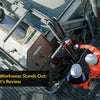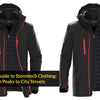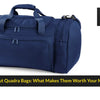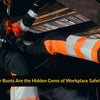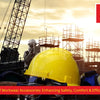Embracing the Future: The Rise of Non-Steel Safety Footwear
- by Mike Johnson

Embracing the Future: The Rise of Non-Steel Safety Footwear
In the realm of industrial safety, non-steel safety footwear stands as a revolutionary innovation, challenging traditional norms and paving the way for a safer, more convenient work environment.
The Evolution of Safety Footwear
Safety footwear has undergone radical transformations over the years, evolving from conventional steel-toe boots to a far more diverse range of options. This progression has been motivated by the need to enhance worker safety without compromising comfort and convenience. As a result, non-steel-toe footwear has emerged as a preferred alternative, offering numerous benefits over traditional steel-toe alternatives.
Steel Toe: The Traditionalist's Choice
Steel-toe boots, the classic design of work safety footwear, have been a staple for workers across various industries. These boots feature a steel cap inside the toe box, designed to protect the wearer's feet from impact, puncture, and compression hazards.
Non-Steel Safety Footwear: The Modern Alternative
Non-steel safety footwear, on the other hand, incorporates protection layers made from materials like carbon fibre, fibreglass, Kevlar, and hard plastics. These materials offer similar safety standards to steel but come with added advantages, including lightweight construction, resistance to temperature fluctuations, and non-conductive properties.
The Advantages of Non-Steel Safety Footwear
The shift towards non-steel safety footwear is driven by the need for practical solutions that address the demands of diverse work environments. Let's delve deeper into the benefits offered by these innovative footwear options.
Enhanced Convenience in Security-Sensitive Areas
In high-security environments like airports, military bases, and government buildings, non-steel safety footwear is a non-negotiable requirement. With no metallic components, these shoes can pass through metal detectors without triggering any alarms, allowing for hassle-free movement.
Light on Your Feet, Heavy on Protection
Non-steel safety footwear features robust yet lightweight materials like fibreglass, Kevlar, or carbon fibre. These materials provide superior strength and support, ensuring optimal foot protection without the added weight of steel.
Thermoneutral Temperature
Unlike steel, non-metallic materials do not conduct heat or cold, providing a thermoneutral environment for your feet. This feature is particularly beneficial for workers operating in extreme temperature conditions.
Uncompromised Safety
Non-steel safety footwear adheres to stringent safety standards, such as ISO 20345. These standards ensure that the footwear can withstand significant impacts and resist compression, providing the same level of safety as traditional steel-toe shoes.
Making the Right Choice
The choice between steel and non-steel safety footwear ultimately depends on the specific requirements of the wearer's work environment. Here are a few factors to consider:
- Job-Specific Requirements: Certain occupations, such as electricians or telecom specialists, may require non-conductive shoes. In such cases, non-steel safety footwear is the ideal choice.
- Working Conditions: If you work in an environment with extreme temperatures or frequent exposure to electrical charges, non-steel safety footwear would be more suitable due to its insulation and non-conductive properties.
- Mobility Needs: If your job requires high mobility or involves walking long distances, non-steel safety footwear would be more comfortable due to its lighter weight.
- Security Constraints: In high-security environments where metal detectors are used, non-steel safety footwear offers greater convenience.
While traditional steel-toe footwear has earned its place in work safety due to its robustness and reliability, non-steel safety footwear presents an innovative alternative that aligns with the evolving demands of modern workplaces. With its distinct benefits, it's no surprise that it's gradually replacing steel-toe footwear in various industries.
In a world where safety, convenience and comfort are paramount, non-steel safety footwear is a game-changer, providing a perfect blend of protection and practicality. So, next time you're shopping for safety footwear, consider giving non-steel options a try. You might just find that it's the perfect fit for your needs.
Frequently asked questions sbout Non-Steel Safety Footwear
What is the alternative to steel-toe shoes?
If you're looking for alternatives to steel toe shoes (often used for protection in industrial and construction settings), you have several options depending on the specific needs and the level of protection required. Here are some alternatives:
- Composite Toe: Made from non-metal materials such as Kevlar, carbon fibre, plastic, or fibreglass. They offer similar protection as steel toes but are lighter and don't conduct heat or cold, making them comfortable in extreme weather conditions. They're also metal-detector friendly, which is useful in specific job settings.
- Aluminum Toe: These are lighter than steel toe caps but offer a similar level of protection. They can be bulkier in appearance than steel toes.
- Carbon Fiber Toe: These are relatively new and are incredibly strong while also being lightweight. They do not conduct temperature, making them comfortable in varying weather conditions.
- Soft Toe: Not designed for impact protection, these are regular shoes. They may still have other safety features like slip resistance or electrical hazard protection, but they don't offer protection from falling or rolling objects.
- Metatarsal Guard: While these don't replace toe protection, they protect the upper foot and toe area from impact. They can be found in conjunction with both steel and composite toe shoes.
- External Toe Cap: These are added onto regular shoes to provide toe protection, though they may not be as effective or comfortable as built-in protection.
- Kevlar Sole Shoes: These shoes protect the bottom of the feet from puncture wounds but don't necessarily offer toe protection. They can be combined with other protective toe options.
When choosing an alternative, it's essential to ensure that the footwear meets the safety standards required for your specific job or activity.
What is metal-free safety shoes?
Metal-free safety shoes are footwear designed for protective purposes in work environments but without any metallic components. Instead of metals, these shoes use composite materials to achieve the necessary safety standards. These materials might include carbon fibre, Kevlar, fibreglass, plastic, or other strong, lightweight, non-metal compounds.
Here are some benefits and features of metal-free safety shoes:
- Lightweight: Because they don't contain heavy metals, metal-free safety shoes tend to be lighter than their steel or aluminium counterparts.
- Non-Conductive: Without metal components, these shoes won't conduct electricity, making them suitable for environments where there's a risk of electrical hazards.
- Thermal Insulation: Metal-free shoes are typically better insulators than metal-based ones, ensuring that your feet are not overly cold in frigid environments or overly hot in warm environments.
- Corrosion Resistance: No metal means no risk of corrosion, which can be advantageous in certain wet or chemical-intensive environments.
- Security-Friendly: If you've ever been through a metal detector at an airport or other security checkpoint, you know that steel-toed shoes can set them off. Metal-free safety shoes are perfect for workers who frequently have to pass through metal detectors, such as at airports.
- Protection: Despite being metal-free, these shoes still offer significant protection. Composite toe caps can provide similar or even superior protection against impact and compression hazards compared to traditional metal options.
- Puncture Resistance: Some metal-free shoes include soles made from materials like Kevlar that resist punctures from sharp objects.
However, it's essential to check that any metal-free safety shoe you're considering meets the required safety standards for your industry or work environment.
Do safety shoes have to be steel toe?
No, safety shoes do not have to be steel toe. While steel toe shoes are a common form of protective footwear, there are various other materials and designs available that can meet or even exceed the protective standards set for specific workplaces or tasks. The choice of safety shoes often depends on the specific hazards present, industry standards, and personal preferences.
Some alternatives to steel toe safety shoes include:
It's important to note that the choice of safety shoe should be based on the hazards of the specific work environment. For example, if the primary hazard is heavy objects falling or rolling onto the foot, a protective toe (be it steel, composite, or aluminium) is essential. On the other hand, if the main risk is from punctures from below, a reinforced sole may be more critical.
Lastly, always ensure that the safety shoes you choose meet the safety standards and certifications required for your industry or job role.
Why do steel toe shoes hurt my feet?
Steel toe shoes, while designed to protect your feet from hazards, can sometimes cause discomfort or even pain for various reasons. If steel toe shoes are causing discomfort, it could be due to one or more of the following reasons:
- Incorrect Size or Fit: This is the most common reason. If your shoes are too tight or too loose, they can cause discomfort. The steel cap might press against the toes if the shoe is too small. Conversely, if the shoe is too big, your foot may slide, causing friction.
- Break-In Period: New steel toe shoes often require a break-in period before they become comfortable. The materials, especially leather, can be stiff initially.
- Shoe Shape: Everyone's feet are unique. Some people might have wider feet, higher arches, or other specific shapes that don't fit well with certain shoe designs.
- Inadequate Cushioning or Support: Some steel toe shoes might not provide enough cushioning or arch support, leading to foot fatigue and pain after prolonged wear.
- Weight: Steel toe shoes are generally heavier than regular shoes. The added weight can be taxing on the feet, especially if you're not used to it.
- Pressure from the Steel Cap: If the steel cap presses against the foot due to bending or crouching, it can cause discomfort.
- Foot Conditions: Pre-existing foot conditions like bunions, hammertoes, or plantar fasciitis can be exacerbated by wearing certain types of shoes, including steel toe shoes.
- Lack of Flexibility: The rigid nature of the steel toe can make the shoe less flexible, affecting natural foot movement.
- Inappropriate Socks: Wearing thin socks or those that don't wick away moisture can cause blisters or other discomforts when combined with the rigidity of steel toe shoes.
If your steel toe shoes are causing discomfort:
- Ensure Proper Fit: Make sure you're wearing the right size. It might help to try on shoes in the evening when your feet are at their largest due to natural swelling.
- Gradually Break Them In: Wear them for short periods initially, gradually increasing the duration.
- Consider Insoles: Adding cushioned insoles can provide additional comfort and support.
- Wear the Right Socks: Thick, moisture-wicking socks can reduce friction and provide an added cushion.
- Rotate Shoes: If possible, rotate between two pairs to give each pair a break and reduce wear and tear.
- Consider Alternatives: If steel toe shoes continue to be uncomfortable, consider trying aluminium toe or composite toe shoes, which might offer a different fit or feel.
If discomfort continues despite these measures, it might be wise to consult with a podiatrist or orthopaedic specialist to ensure there aren't underlying issues or to get recommendations for orthotic insoles tailored to your needs.
Can an employee refuse to wear safety shoes?
Whether or not an employee can refuse to wear safety shoes largely depends on the work environment, the specific job role, local laws, and the company's policies. Here are some considerations:
- Safety Regulations: Many industries and job roles have stringent safety regulations. In sectors where there's a high risk of foot injuries, such as construction, manufacturing, and many others, safety shoes are often mandatory. Refusing to wear them could mean violating workplace safety standards.
- Legal Consequences: In many countries, workplace safety is regulated by government agencies. Employers are legally obligated to ensure their workers have and use appropriate personal protective equipment (PPE), including safety shoes. An employee's refusal might not only jeopardise their own safety but could also have legal repercussions for the employer.
- Employer's Right: Generally, employers have the right to set dress codes and require specific uniforms or protective gear, including safety shoes. If wearing such shoes is part of the job requirement, an employee's refusal could lead to disciplinary actions, including termination.
- Medical or Religious Exemptions: There may be specific situations where an employee has a valid medical or religious reason to not wear standard safety shoes. In such cases, employers may need to consider reasonable accommodations as long as they don't compromise safety standards.
- Communication is Key: If an employee feels that safety shoes are causing discomfort or health issues, it's essential to communicate these concerns to the employer. There might be alternative footwear that meets safety standards and is more comfortable for the employee.
- Alternative Roles: In some cases, if an employee cannot or will not wear safety shoes due to valid concerns, they might be reassigned to a role where such shoes are not required if such a role exists and is feasible.
In summary, while an employee might have personal reasons for not wanting to wear safety shoes, these reasons need to be weighed against safety regulations, company policies, and the inherent risks of the job. Safety shoes are designed to protect, and in environments where hazards exist, they are a critical component of workplace safety.

